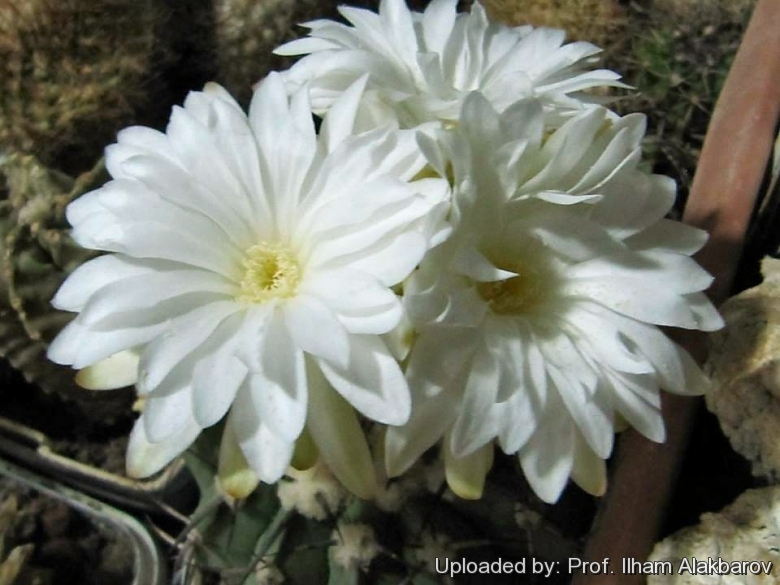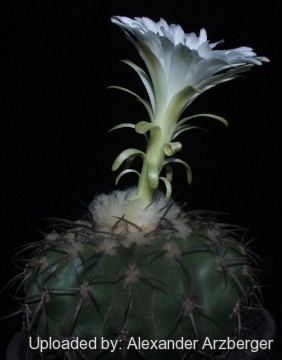




Your support is critical to our success.
Allg. Gartenzeitung (Otto & Dietrich) (Otto & Dietrich) 5: 241. 1837
Family: CACTACEAE
Accepted Scientific Name: Discocactus placentiformis (Lehm.) K.Schum.
Nat. Pflanzenfam. Nachtr. [Engler & Prantl] iii. 6 a. (1894) 190.

Origin and Habitat: Discocactus insignisSN|21884]]SN|1463]] occurs intermittently over a small area in the neighbourhood of Grao Mogol, Minas Gerais, Brazil.
Altitude range: 700-1000 metres above sea level.
Habitat and ecology: Plants grow mostly in pure quartzite sand and gravel down hill of the habitat of Discocactus horstiiSN|1463]]SN|21884]] among shrubs like thorny Acacias and various kinds of small trees.
Synonyms:
- Discocactus insignis Pfeiff.
Discocactus placentiformis (Lehm.) K.Schum.
Nat. Pflanzenfam. Nachtr. [Engler & Prantl] iii. 6 a. (1894) 190.
Synonymy: 26
- Discocactus placentiformis (Lehm.) K.Schum.
- Cactus placentiformis Lehm.
- Echinocactus placentiformis (Lehm.) K.Schum.
- Discocactus alteolens Lem. ex A.Dietr.
- Cactus alteolens (Lem.) Kuntze
- Discocactus alteolens Schum.
- Discocactus placentiformis subs. alteolens (Lem.) P.J.Braun & Esteves
- Discocactus placentiformis var. alteolens (Lem.) P.J.Braun & Esteves
- Echinocactus alteolens (Lem. ex A.Dietr.) K.Schum.
- Discocactus besleri F.A.C.Weber
- Discocactus crystallophilus Diers & Esteves
- Discocactus insignis Pfeiff.
- Discocactus latispinus Buining ex Bredero ex J.Theun.
- Discocactus linkii Pfeiff.
- Discocactus multicolorispinus P.J.Braun & Bredero
- Discocactus placentiformis subs. multicolorispinus P.J.Braun & Esteves
- Discocactus placentiformis var. minor-horridulus n.n.
- Discocactus pseudolatispinus Diers & Esteves
- Discocactus latispinus subs. pseudolatispinus (Diers & Esteves) P.J.Braun & Esteves
- Discocactus pugionacanthus Buining & Bredero ex J.Theun.
- Discocactus placentiformis subs. pugionacanthus (Buining & Bredero) P.J.Braun & Esteves
- Discocactus placentiformis var. pugionacanthus (Buining & Bredero) P.J.Braun & Esteves
- Discocactus pulvinicapitatus Buining & Bredero
- Discocactus latispinus subs. pulvinicapitatus (Buining & Bredero) P.J.Braun & Esteves
- Discocactus tricornis Monv. ex Pfeiff.
- Echinocactus tricornis Monv. ex A.Dietr.
Description: Discocactus insignisSN|1444]]SN|1463]] is one of the several morphogical or local forms of the very variable Discocactus placentiformisSN|1430]]SN|1430]] and now fully synonymized with the latter. This plant looks similar to the other “placentiformis”, but with 5 to 7 spines of which the lowest one more long and recurved backwards to the plant. All the other characteristics show that they are congeneric, namely size and form of tubercles, flowers and fruits and the two plants are not readily distinguishable, if not for the geographical provenance. Discocactus latispinusSN|1463]]SN|1444]] blooms on warm summer nights. Its fragrant flowers are pollinated by moths.
Stem: Low, flattened-globular, less than 10 cm tall (without cephalium about 3,5-8 cm), about 14 cm in diameter, epidermis is dark green, with woolly cephalium.
Ribs: About 14, sharp up to 1,5 cm high, not or only slightly tuberculate, distinctly enlarged at the areoles and without acute sinuses between adjacent areoles on the same rib.
Areoles: Oval about 9 on each rib on plants with cephalium.
Cephalium: Up to 8 cm tall , 4-6 cm in diameter, with cream-white wool.
Radial spines: 5 to 7, grey with a black tip, becoming grey with age, about 6 mm long (upwards ones) and 16 mm long (downwards ones) and up to 2 mm thick, the lateral almost straight while the lowest pointing downwards, clawlike and recurved backwards to the plant.
Central spine: In some plants one central spine appears, but is usually absent. It is erect, 1,5-2 cm long.
Flowers: Nocturnal lasting only a single night, and rapidly collapsing into mush the next morning, extremely fragrant, slender funnelform, up to to 7,5 cm long, white arising from the cephalium. The position of the stigma is 3/4 up the secondary stamens.
Blooming season: Summer, it needs a good exposure to with some sun to bloom , so it's pretty rare to have blossoms when in cultivation in greenhouses. It is not unusual for this Melocactus to take 7 or more years before it starts blooming, but once it does, it should every year.
Fruit: Club shaped pink/white, up to 3 cm long and 0,8 cm in diameter containing a few black seeds.
Subspecies, varieties, forms and cultivars of plants belonging to the Discocactus placentiformis group
 Discocactus crystallophilus Diers & Esteves: has (3)5-7 brown-reddish to pale grey spines, lateral to 2 cm long, lowermost one to 3 cm long. Uppermost about 5 mm long. Distribution: Minas Gerais.
Discocactus crystallophilus Diers & Esteves: has (3)5-7 brown-reddish to pale grey spines, lateral to 2 cm long, lowermost one to 3 cm long. Uppermost about 5 mm long. Distribution: Minas Gerais.  Discocactus insignis Pfeiff.: has 5 to 7 spines of which the lowest one more long and recurved backwards to the plant. Distribution: neighbourhood of Grao Mogol, Minas Gerais, Brazil.
Discocactus insignis Pfeiff.: has 5 to 7 spines of which the lowest one more long and recurved backwards to the plant. Distribution: neighbourhood of Grao Mogol, Minas Gerais, Brazil. Discocactus latispinus Buining ex Bredero ex J.Theun.: has 5 spines of which the lowest one more long and characteristically flattened. distribution: Joaquim Felicio and adjacent areas, Minas Gerais.
Discocactus latispinus Buining ex Bredero ex J.Theun.: has 5 spines of which the lowest one more long and characteristically flattened. distribution: Joaquim Felicio and adjacent areas, Minas Gerais. Discocactus multicolorispinus P.J.Braun & Bredero: spines mostly amber like, but variable in colouration (multicolored) hence the name. Distribution: Serra do Espinhaco in Minas Gerais. Brasil.
Discocactus multicolorispinus P.J.Braun & Bredero: spines mostly amber like, but variable in colouration (multicolored) hence the name. Distribution: Serra do Espinhaco in Minas Gerais. Brasil. Discocactus placentiformis (Lehm.) K.Schum.: is a small flattish globular cactus, with woolly cephalium. It is one of the most widely distributed and variable species. Distribution: whidespread in Minas Gerais.
Discocactus placentiformis (Lehm.) K.Schum.: is a small flattish globular cactus, with woolly cephalium. It is one of the most widely distributed and variable species. Distribution: whidespread in Minas Gerais. Discocactus placentiformis var. minor-horridulus n.n.: has smaller stems, with 5(-7) spines of which the lowest one more long and flattened. Flower often pink in the exterior. Distribution: Diamantina, Minas Gerais, Brazil.
Discocactus placentiformis var. minor-horridulus n.n.: has smaller stems, with 5(-7) spines of which the lowest one more long and flattened. Flower often pink in the exterior. Distribution: Diamantina, Minas Gerais, Brazil. Discocactus pulvinicapitatus Buining & Bredero: is very similar to Discocactus latispinus, but is larger size and has a larger cephalium. Distribution: Central part of Minas Gerais, Brazil.
Discocactus pulvinicapitatus Buining & Bredero: is very similar to Discocactus latispinus, but is larger size and has a larger cephalium. Distribution: Central part of Minas Gerais, Brazil. Discocactus tricornis Monv. ex Pfeiff.: has 3 radial spines pointing downward, occasionally accompanied by 2-3 very short spines pointing upward. (same as Discocactus alteolens?). Distribution. Eastern central Brazil.
Discocactus tricornis Monv. ex Pfeiff.: has 3 radial spines pointing downward, occasionally accompanied by 2-3 very short spines pointing upward. (same as Discocactus alteolens?). Distribution. Eastern central Brazil.
Bibliography: Major references and further lectures
1) Edward Anderson “The Cactus family” Timber Press, Incorporated, 2001
2) James Cullen, Sabina G. Knees, H. Suzanne Cubey "The European Garden Flora Flowering Plants: A Manual for the Identification of Plants Cultivated in Europe, Both Out-of-Doors and Under Glass" Cambridge University Press, 11/August /2011
3) David R Hunt; Nigel P Taylor; Graham Charles; International Cactaceae Systematics Group. "The New Cactus Lexicon" dh books, 2006
4) Edgar Lamb, Brian Lamb “The Illustrated Reference on Cacti & Other Succulents” Volume 5 Blandford Press, 1978
5) Venlo “Discocactus” page 78-89 1980
6) Piet van der Laken “Discocactus insignis HU347” Discocactus South American Jewels. <http://www.discocactus.nl/Engels/speciesE/insignisE.htm> Web. 20 Dec. 2014.

Discocactus insignis Photo by: Alexander Arzberger

Discocactus insignis Photo by: Alexander Arzberger
Cultivation and Propagation: Discocactus insignis (Discocactus placentiformisSN|1430]]SN|1430]]) is not the easiest plant to keep happy, so it isn't a plants for beginners, in fact collectors consider the Discocactus to be rarities which requires skilful cultivation. Under glass, it isn't difficult, but appreciates milder winter temperatures and more generous summer watering than most of the other genera of compact cacti. When grown to maturity, however, it possess an exotic look shared by no other cacti, and it generally attract a lot of attention.
Growing rate: It is slow growing. Seedlings up to one year grow very slowly. When the plants are older there are no problems in cultivation.
Soil: It likes very porous standard cactus mix soil. Prefer a low pH compost, avoid substrata rich in limestone; otherwise growth will stop altogether.
Repotting: They generally resent being repotted and can take a long time to establish.
Fertilization: Feed with a high potassium fertilizer in summer.
Exposition: The plant tolerates bright situations but enjoys filtered sunlight or afternoon shade, inside it needs bright light, and some direct sun. Tends to bronze in strong light, which encourages flowering and heavy spine production.
Waterings: Discocacti are very rot prone when kept on their own roots and though they can’t endure long stretches of total dryness, too much water with cool will rot them, as their weak root systems tend to be inefficient at sucking up water from wet soil.
Hardiness: It is rather difficult to grow and frost tender, it can’t stand cold, or even fairly cool temperatures and should be kept at above 15° C if grown on its own roots (8°C if grafted).
Uses: It is an excellent plant for container growing. It always looks good and stays small.
Pests & diseases: It may be attractive to a variety of pests or diseases:
- Red spiders: Red spiders may be effectively rubbed up by watering the plants from above.
- Mealy bugs: Mealy bugs occasionally develop aerial into the new growth among the wool with disfiguring results, but the worst types develop underground on the roots and are invisible except by their effects.
- Scales: Scales are rarely a problem.
- Rot: Rot it is only a minor problem with cacti if the plants are watered and “aired” correctly. If they are not, fungicides won't help all that much.
Propagation: Seeds or grafting. Seeds germinate in 7-14 days at 21-27° C in spring, remove gradually the glass cover as soon the plants will be well rooted (ca 1-2 weeks) and keep ventilated, no full sun for young plants! Seedlings up to one year growth very slowly. When the plants are older there are no problems in cultivation. Young seedlings are often grafted on a low stock to keep the plant in a good shape.
| Your Actions | |
|---|---|
| Back to Discocactus index | |
| Back to Cactaceae index | |
 |
Back to Cacti Encyclopedia index |
Privacy stantement - Terms and conditions - How to cite - About us - Feedback - Donate



